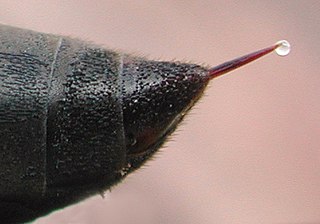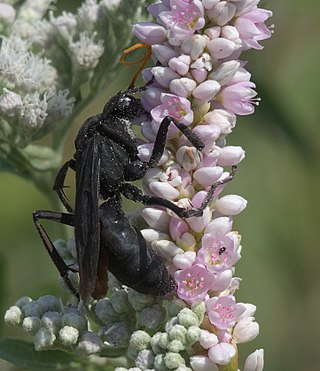
Sceliphron caementarium, also known as the yellow-legged mud-dauber wasp, black-and-yellow mud dauber, or black-waisted mud-dauber, is a species of sphecid wasp. There are some 30 other species of Sceliphron that occur throughout the world, though in appearance and habits they are quite similar to S. caementarium.

Apocrita is a suborder of insects in the order Hymenoptera. It includes wasps, bees, and ants, and consists of many families. It contains the most advanced hymenopterans and is distinguished from Symphyta by the narrow "waist" (petiole) formed between the first two segments of the actual abdomen; the first abdominal segment is fused to the thorax, and is called the propodeum. Therefore, it is general practice, when discussing the body of an apocritan in a technical sense, to refer to the mesosoma and metasoma rather than the "thorax" and "abdomen", respectively. The evolution of a constricted waist was an important adaption for the parasitoid lifestyle of the ancestral apocritan, allowing more maneuverability of the female's ovipositor. The ovipositor either extends freely or is retracted, and may be developed into a stinger for both defense and paralyzing prey. Larvae are legless and blind, and either feed inside a host or in a nest cell provisioned by their mothers.

A tarantula hawk is a spider wasp (Pompilidae) that preys on tarantulas. Tarantula hawks belong to any of the many species in the genera Pepsis and Hemipepsis. They are one of the largest parasitoid wasps, using their sting to paralyze their prey before dragging it to a brood nest as living food; a single egg is laid on the prey, hatching to a larva which eats the still-living host. They are found on all continents other than Europe and Antarctica.

Wasps in the family Pompilidae are commonly called spider wasps, spider-hunting wasps, or pompilid wasps. The family is cosmopolitan, with some 5,000 species in six subfamilies. Nearly all species are solitary, and most capture and paralyze prey, though members of the subfamily Ceropalinae are kleptoparasites of other pompilids, or ectoparasitoids of living spiders.

A stinger is a sharp organ found in various animals capable of injecting venom, usually by piercing the epidermis of another animal.
Hymenoepimecis argyraphaga is a Costa Rican parasitoid wasp whose host is the spider Plesiometa argyra. The wasp is unusual in modifying the spider's web building behavior to make a web made of very strong lines designed to support the wasp's cocoon without breaking in the rain.

Mud dauber is a name commonly applied to a number of wasps from either the family Sphecidae or Crabronidae which build their nests from mud; this excludes members of the family Vespidae, which are instead referred to as "potter wasps". Mud daubers belong to different families and are variable in appearance. Most are long, slender wasps about 1 inch (25 mm) in length. The name refers to the nests that are made by the female wasps, which consist of mud molded into place by the wasp's mandibles. Mud daubers are not normally aggressive, but can become belligerent when threatened. Stings are uncommon.

The organ pipe mud dauber is a predatory wasp in the family Crabronidae.It is fairly large, ranging from 3.9–5.1 cm, and has been recorded to fly from May to September. Females and males are similar in colour, a shiny black, with the end part of the back leg being pale yellow to white. The organ pipe mud dauber feeds mainly on three genera of spider: Neoscona, Araneus, and Eustala. Melittobia, a parasitoid wasp, is a common ectoparasite of T. politum prepupae. Other sources of parasitism include the bombyliid fly Anthrax, chrysidid wasps, and various species of scavenger flies (Miltogramminae). The tufted titmouse is a known predator of T. politum, and may feed on them more commonly than previously thought, as the holes made by the titmouse are similar in shape and size to those made by T. politum leaving the nest after pupation.

Potter wasps, the Eumeninae, are a cosmopolitan wasp group presently treated as a subfamily of Vespidae, but sometimes recognized in the past as a separate family, Eumenidae.

The Ampulicidae, or cockroach wasps, are a small, primarily tropical family of sphecoid wasps, all of which use various cockroaches as prey for their larvae. They tend to have elongated jaws, pronounced neck-like constrictions behind the head, strongly petiolate abdomens, and deep grooves on the thorax. Many are quite ant-like in appearance, though some are brilliant metallic blue, green, and hot pink.

Phormictopus cancerides, also known as the Hispaniolan giant tarantula, is a tarantula endemic to Hispaniola in the Caribbean.

A wasp is any insect of the narrow-waisted suborder Apocrita of the order Hymenoptera which is neither a bee nor an ant; this excludes the broad-waisted sawflies (Symphyta), which look somewhat like wasps, but are in a separate suborder. The wasps do not constitute a clade, a complete natural group with a single ancestor, as bees and ants are deeply nested within the wasps, having evolved from wasp ancestors. Wasps that are members of the clade Aculeata can sting their prey.

The Pepsinae are a subfamily of the spider wasp family, Pompilidae, including the tarantula hawks, as well as smaller species.

Priocnemis monachus is a species of spider wasp endemic to New Zealand, where it is known as the black hunting wasp or ngaro wīwī. It hunts large tunnelweb or trapdoor spiders, paralysing them with its sting and storing them in burrows for its larvae to eat alive. It is the largest member of the family Pompilidae in New Zealand.

Hemipepsis ustulata is a species of tarantula hawk wasp native to the Southwestern United States. Tarantula hawks are a large, conspicuous family of long-legged wasps that prey on tarantulas. They use their long legs to grapple with their prey before paralyzing them with a powerful sting. Their stings are ranked as some of the most painful in the insect world according to the Schmidt sting pain index. They are solitary, displaying lekking territorial behavior in their mating rituals.

Batozonellus is a genus of the spider hunting wasps.

Batozonellus lacerticida is a species of the spider-hunting wasp of the family Pompilidae.

Entypus is a genus of spider wasps in the family Pompilidae. There are at least 40 described species in Entypus.

Anoplius aethiops is a species of spider wasp in the family Pompilidae. It primarily lives in overgrown fields with fine-grained soil. It provisions its young with paralyzed Lycosidae spiders, especially those of the genus Hogna.

Entypus fulvicornis is a species of spider wasp belonging to the family Pompilidae. It is found in North America.
















